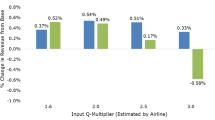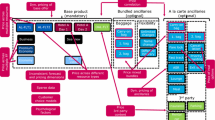Abstract
In early 2016, ATPCO formed the dynamic pricing working group to address airline requirements for creating customized offers in both traditional and NDC environments. The working group comprises a coalition of about 20 airlines, three GDSs, along with several marketing and technology providers. One of the main work streams in this forum involves developing industry-standard, interoperability specifications for airline dynamic fare adjustment and fare generation for traditional distribution; recent progress on this work and discussion of current draft specifications are covered in this paper.




Similar content being viewed by others
Notes
Per the Wikipedia: a stateless protocol does not require the server to retain session information or status about each communications partner for the duration of multiple requests. In contrast, a protocol that requires keeping of the internal state on the server is known as a stateful protocol.
References
ATPCO. 2015. Dynamic Pricing: Definition, Impact, and Current Capabilities. In ATPCO Whitepaper. https://www.atpco.net/sites/default/files/all%20pdfs/dynamic%20pricing%20definition%20impact%20and%20current%20capabilities.pdf. Accessed Sept 2015.
Belobaba, B., W. Brunger, and M. Wittman. 2017. Advances in Airline Pricing, Revenue Management, and Distribution: Implications for the Airline Industry. POD Research LLC. Discussion Paper prepared for ATPCO, October 2017.
Fiig, T., L. Choubert, and V. Viale. 2015. Amadeus Dynamic Pricing. Presentation at AGIFORS Revenue Management Study Group Meeting. Shanghai, China.
Gallego, G., and N. Chen. 2016. Do Consumers Benefit from Dynamic Pricing? Presentation at AGIFORS Revenue Management Study Group Meeting. Frankfurt, Germany.
Ratliff, R., and B. Vinod. 2005. Airline pricing and revenue management: a future outlook. Journal of Pricing and Revenue Management 4 (3): 302–307.
Acknowledgements
The authors would like to thank the editors of this special issue, the anonymous reviewers, and the many individuals who participated in helping develop the specifications as part of the ATPCO dynamic pricing working group. In particular, we would like to thank Gene Bartholf, Luc Choubert, Fred Foote, Tom Gregorson, Ellen Runyon, Christian Huff, John McDonnell, Ben Vinod, and Ross Darrow for their generous assistance.
Author information
Authors and Affiliations
Corresponding author
Appendices
Appendix A
Business overview of airline dynamic pricing
The ATPCO DP connectivity specifications explicitly state that the business logic for pricing decision making contained within the airline dynamic pricing engine is out of scope of the document. Nonetheless, the authors believed that a brief discussion of the underlying business rationale and benefits derived from DP would be helpful for those readers who are unfamiliar with these technologies.
During the past decade, numerous airlines and vendors have discussed the use of airfare search shopping data sources, customer choice models and fare optimization algorithms to help airlines continually adapt their selling price positioning to maximize profits. Ratliff and Vinod (2005) described these emerging, market-adaptive dynamic pricing models as the next wave of advanced pricing and revenue management (RM) science. Airlines and vendors have been working on how these new tools could be employed by airlines for improved pricing and RM performance in their own and global distribution system channels.
“Dynamic pricing” has many different meanings both within and outside of the airline industry. Since airfares and/or availability can change many times during the selling horizon prior to departure, many economists point to the existing airline distribution environment as a textbook industry example of dynamic pricing. Other individuals describe dynamic pricing as modifying booking class availability dynamically. Still others refer to dynamic pricing as changing the price levels themselves (either by creating a new, instantaneous airfare or modifying the price of an existing fare product). We believe our vision of dynamic pricing corresponds most closely to that described in Belobaba et al. (2017): “With continuous pricing, firms select a price from a continuous range of possible values. There is no underlying finite menu of possible price points, although there may be business rules that determine the range of allowable prices at any moment. At the limit, dynamic prices could be generated individually for each transaction (transactional dynamic pricing). However, prices do not necessarily need to differ from transaction to transaction.”
Appendix B
Contrasting dynamic availability and pricing
Another approach that was considered by the ATPCO DP working group is dynamic availability (ATPCO whitepaper 2015). A brief summary of the approach and a comparison with DP is provided here for reference.
Traditional pricing practices involve airlines filing fare products for a set of markets and date ranges (typically spanning a season); the new prices go into effect once the filing process has been completed via ATPCO (or other vendor) and distributed through the GDSs. Traditional availability practices involve airlines using their revenue management systems to set specific booking classes as open or closed by market, flight(s) and departure date. Dynamic availability (DA) involves automated, online adjustments to booking class availability for a specific market and departure date in response to specific customer segmentation logic or market conditions. For example, an airline’s discount booking class may be opened up on a given market and departure date for particular customer segments thus allowing fares mapped into that booking class to become available for sale. Most airlines today already have a more limited form of dynamic availability based on numeric sales limits by class; we have excluded this from our definition. Dynamic pricing (our definition) involves directly changing price levels online (via either a new fare product or changes to an existing one) for a specific market and departure date (and return date in the case of roundtrip fares) in response to specific customer segmentation or market condition information. For example, after factoring in current competitor price information from low fare shopping results for a given market and date(s), an airline may decide to apply a 2% discount to its current price levels on its connecting itineraries in order to be more competitive. In our definition, both DA and DP would provide immediate availability or prices changes in response to shopping or pricing requests without following the normal fare filing procedures as practiced currently. Both approaches provide the potential for improved automation and transaction-level pricing changes.
One of the work streams in the DP working group was focused on dynamic availability. Initially, the working group looked at the possibility of expanding the number of reservation booking designators (RBDs) from a single to two-character element. This expansion would represent a significant impact to existing systems and infrastructure. ATPCO developed an alternative proposal to use dual RBD validation as a method for increasing the number of price points available within a cabin.
Currently, carriers are restricted to twenty-six single alpha characters to manage their availability. These RBDS are further divided by cabin and some may be defined for internal carrier use only (e.g., employee business travel, frequent flyer redemption), further reducing the number for use. Many inventory management systems can accommodate more buckets than the 26 RBDs represent.
ATPCO proposes allocating a subset of the 26 RBDs as secondary RBD validation to manage discount fare levels within a primary RBD. This effectively allows for price adjustment by allowing the closing of an RBD that would have been indicated open and then leaving a higher RBD with discounted fare levels open.
In Fig. 5, a table comparing the similarities and differences between dynamic availability and pricing is provided.
Rights and permissions
About this article
Cite this article
Dezelak, M., Ratliff, R. Towards new industry-standard specifications for air dynamic pricing engines. J Revenue Pricing Manag 17, 394–402 (2018). https://doi.org/10.1057/s41272-018-0148-y
Received:
Accepted:
Published:
Issue Date:
DOI: https://doi.org/10.1057/s41272-018-0148-y





